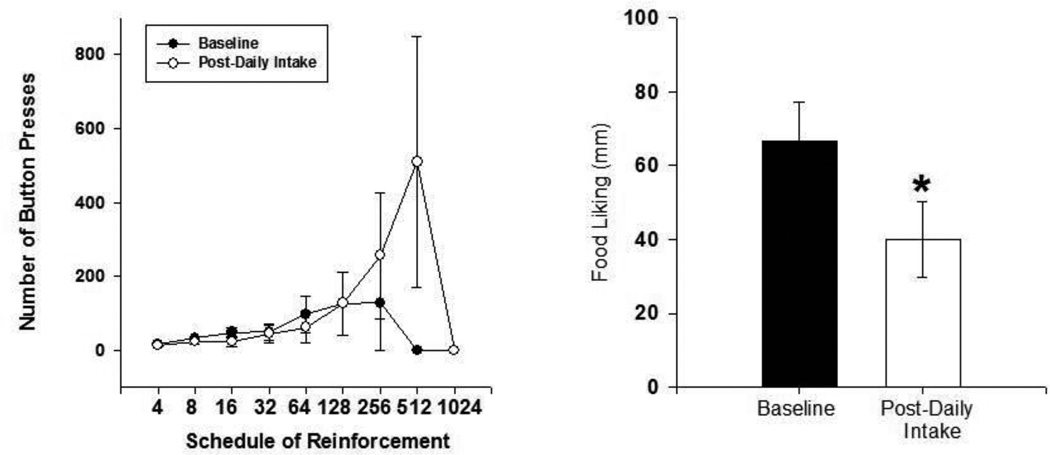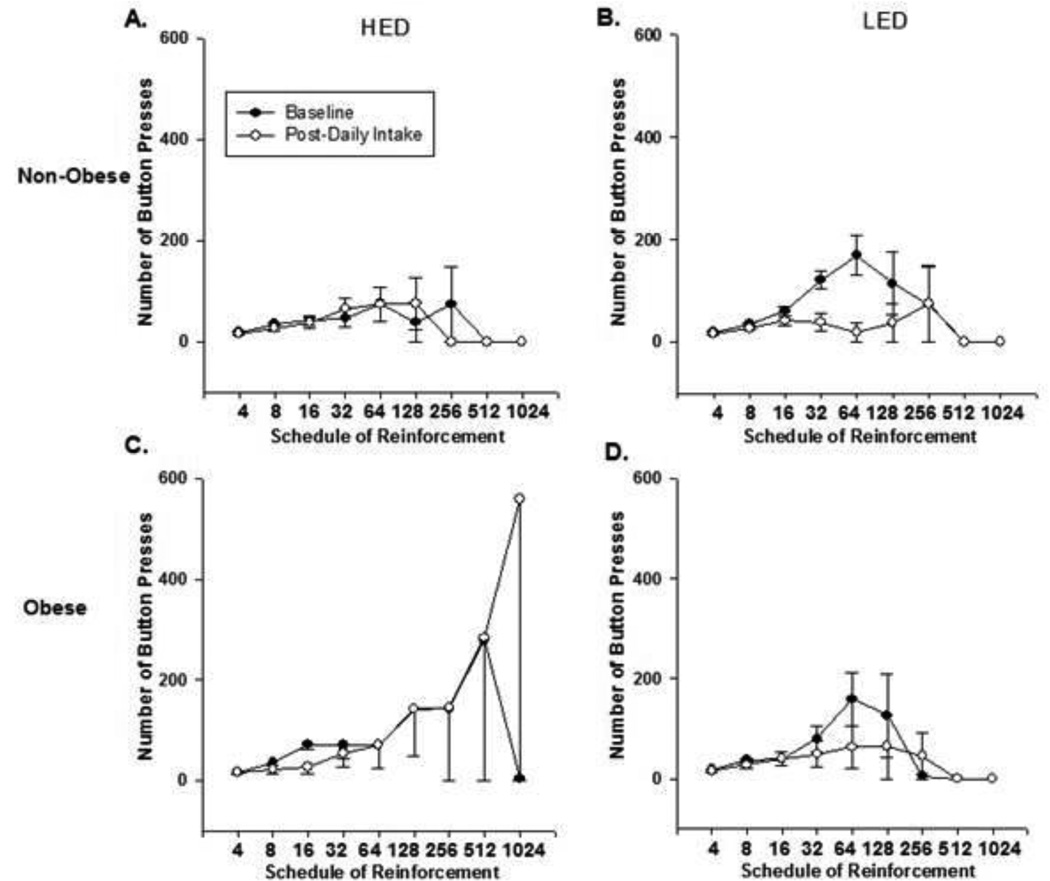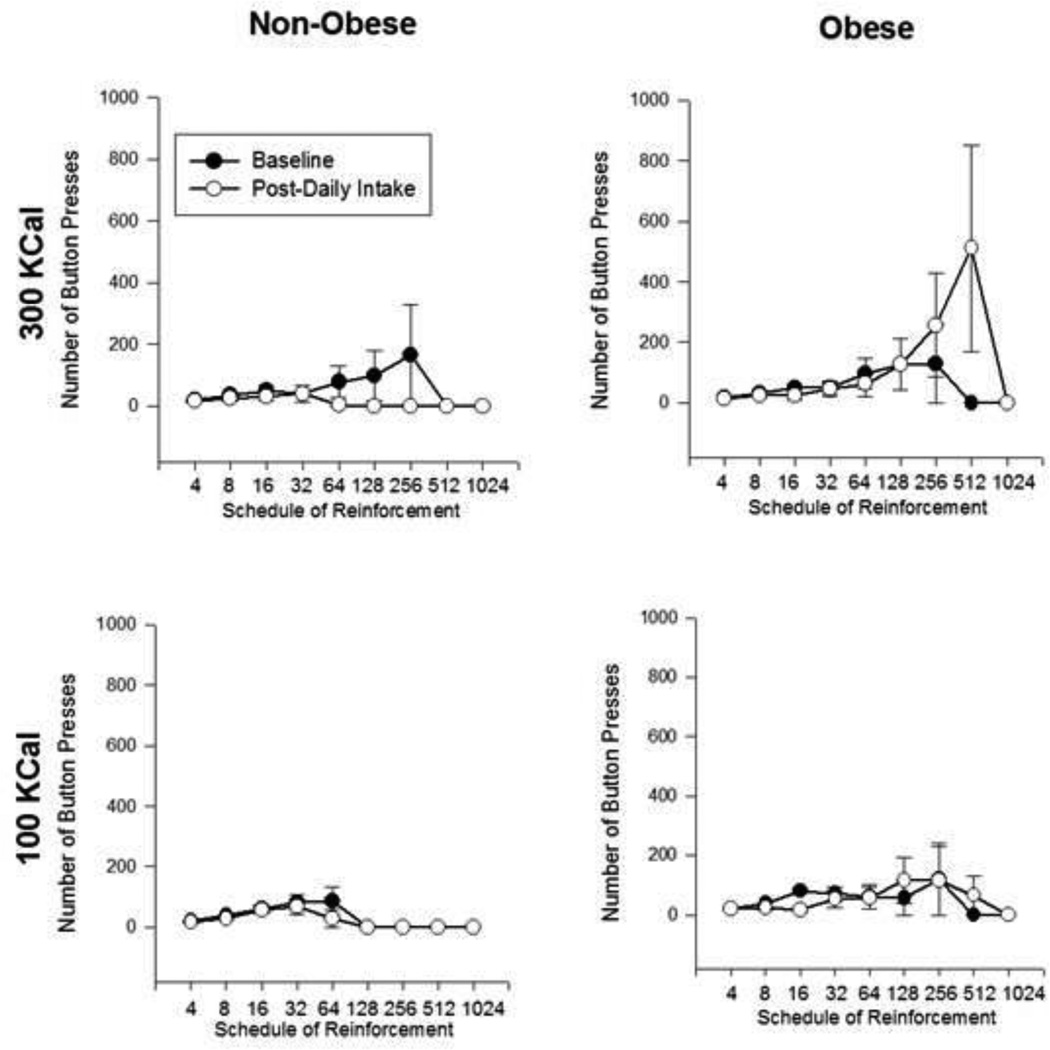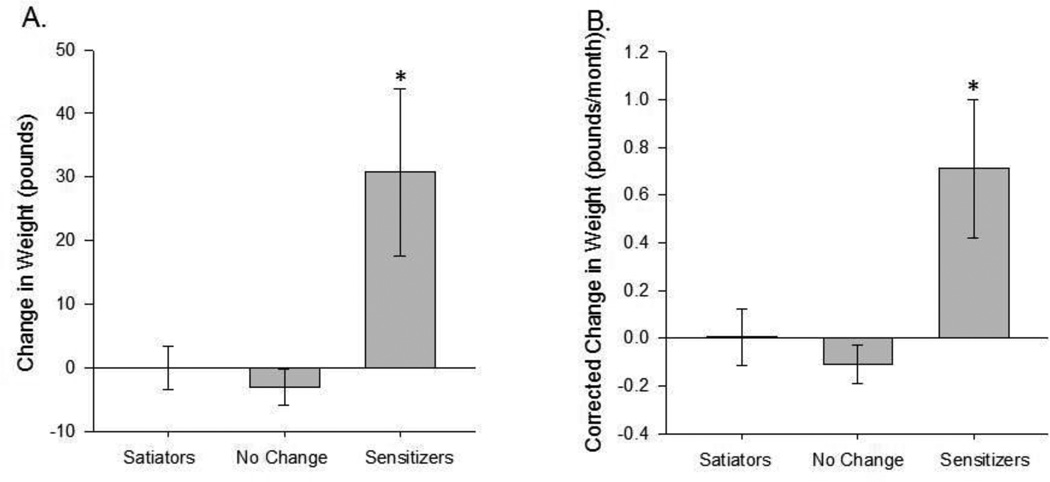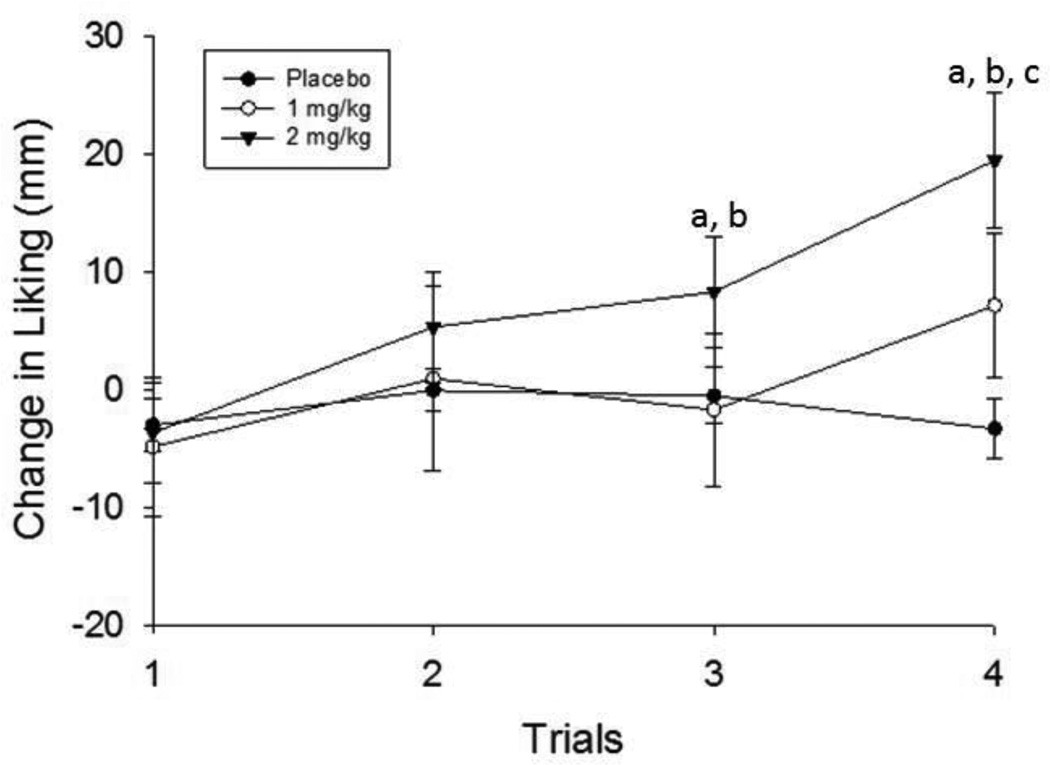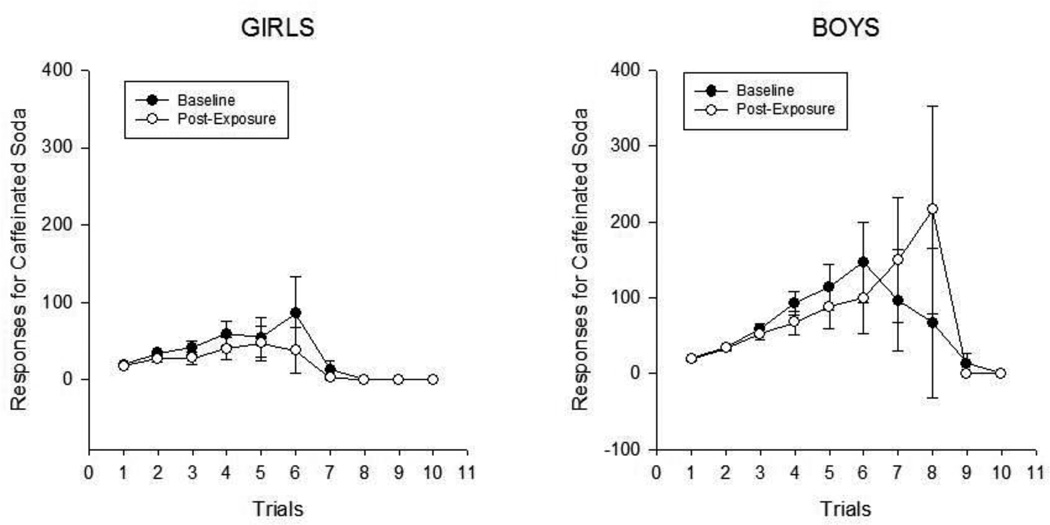Abstract
Behavioral economic principles state that as the cost of a product increases, purchasing or consumption of that product will decrease. To understand the impact of behavioral economics on ingestive behavior, our laboratory utilizes an operant behavior paradigm to measure how much work an individual will engage in to get access to foods and beverages. This task provides an objective measure of the reinforcing value. We have shown that consumption of the same high fat snack food every day for two weeks reduces its reinforcing value in lean individuals, but increases its reinforcing value in a subset of obese individuals. This increase in the reinforcing value of food predicts future weight gain. Similarly, we have shown that repeated intake of caffeinated soda increases its reinforcing value in boys, but not in girls. This increase in reinforcing value is not related to usual caffeine consumption, but may be associated with positive, subjective effects of caffeine that are more likely to be reported by boys than by girls. Because food and beverage reinforcement relates to real-world consumption, it is important to determine factors that increase or decrease the reinforcing value and determine the consequences of these responses. We are especially interested in determining ways to shift the behavioral economic curve in order to develop novel strategies to decrease the reinforcing value of less healthy snack foods and beverages, such as soda, potato chips and candy and to increase the reinforcing value of healthier foods and beverages, such a water, fruits, and vegetables.
1.0 Introduction
Eating occurs for many reasons that depend on internal state, such as hunger, recent experience with the food, physiological signals such as blood glucose and insulin and external cues, such as sight and smell of food, time of day, and the price of food. The relationship among these factors and how this relationship influences ingestive behavior can be studied using a behavioral economic framework. This framework allows us to manipulate the behavioral cost of food and determine factors that influence the willingness of individuals to work for that food. This is referred to as the reinforcing value of food.
We and others have examined factors that can impact the reinforcing value of food in both children and adults. Previous studies have shown that hunger and food deprivation can increase the reinforcing value of food [1–3], while fullness and recent experience with a food can reduce the reinforcing value of food [4, 5]. In addition, we and others have shown that the reinforcing value of food differs as a function of body mass index (BMI) in both children and adults with higher BMI predicting greater reinforcing value of food [6–9]. Our recent work has explored several other factors that influence the reinforcing value of food and beverages and have shown that some of these predict weight change over time. This review will highlight those recent findings and discuss implications for future studies.
2.0 Reinforcing Value of Food
A reinforcer is something that increases the probability of a behavior which it follows. For example, a child that is given a chocolate for cleaning his room may be more likely to clean his room than if he were given no chocolate. The reinforcing value of food is defined as the amount of behavior that a given food will support. There are a number of ways to assess the reinforcing value of food. For example, in animals, lever pressing behavior can be measured. In this case, an animal presses on a lever and, after a certain number of lever presses, a food pellet is given [10]. This is a standard technique used to examine, not only the reinforcing value of food, but the reinforcing value of a variety of stimuli, such as drugs, alcohol, or intracranial self-stimulation. In humans, there are different methods that are used to determine reinforcing value of food. One method involves asking people to make a choice between a portion of a specified food and an alternative reinforcer, such as money. The point at which the person switches from choosing food to choosing money is an index of the reinforcing value of food. There are more objective ways to measure the reinforcing value of food that are analogous to the lever pressing tasks used in animals. Briefly, participants make responses on a computer mouse for access to food only or for access to either food or an alternative reinforcer, such as sedentary activity, or in some situations, two different types of food [11, 12]. Another important component of this task is that after a reinforcer is earned, it becomes harder to earn the next one. The reinforcing value of food is assessed by evaluating the number of responses made for food or alternatives on these progressive ratio schedules of reinforcement [11, 12].
3.0 Liking vs. Reinforcing Value
Many of the foods and beverages that we find reinforcing are also ones that are highly liked. So, naturally, we associate liking and reinforcing value. However, food liking is a subjective measurement of self-reported hedonic responses for a food or beverage and the reinforcing value of food can be measured objectively by determining how hard an individual will work for food, so it is possible to dissociate liking and wanting empirically. This is important because there are factors which may alter liking, but not reinforcing value and factors that may alter reinforcing value, but not liking. We and others have shown that liking may change in the absence of a change in reinforcing value or vice versa (Figure 1) [6, 13]. This may be because there are different factors that influence liking and wanting or that liking and wanting are controlled by different regions in the brain [14]. It also may be important to dissociate liking and wanting for a food because some foods that would be desirable for people to want to eat, such a vegetables, may not be highly liked, so determining how to increase motivation to eat foods that are less liked could improve diet quality. It is not clear what the dissociation between liking and wanting tells us about a person’s eating behavior outside of the laboratory or risk for obesity. More work needs to be done to understand the potential importance of liking and wanting for real-world eating behavior.
Figure 1.
The number of responses for snack food across different schedules of reinforcement in obese participants who consumed 300 kcal portions (left) and self-reported liking of the snack food at baseline (black bar) and again after two weeks of consumption of 300 kcal portions (white bar) in the same participants. The obese participants who consumed the 300 kcal portions showed an increase in food reinforcement after the two weeks (p < 0.0001 despite the fact that they rated the food significantly less liked (p < 0.05).
4.0 Monotony and Sensory Specific Satiety
Repeated exposure to the same food causes a decrease in hedonic ratings for that food while hedonic ratings for uneaten foods remain the same. This is commonly observed when people eat meals and report a decrease in desire to eat their meal food, but have room for dessert. This decrease in hedonic ratings over a single meal is referred to as sensory specific satiety and has been studied and described in detail by Barbara Rolls and colleagues [15–17]. A decrease in hedonic ratings for foods eaten over days and weeks is referred to as monotony [18, 19]. While hedonic ratings for most foods decrease within a single eating occasion, there are categories of food that are resistant to monotony, sometimes referred to as staple foods [18]. As mentioned above, the relationship between hedonics and food reinforcement is not always straightforward. It is important to understand how eating patterns that alter food hedonics change the reinforcing value of food. Our previous research suggests that repeated administration of the same snack food results in a decrease in the reinforcing value of food in non-obese individuals, but it increased the reinforcing value of food in a subset of obese individuals [6, 8, 20].
5.0 Factors that Influence the Reinforcing Value of Food
5.1 Hunger/Fullness
The reinforcing value of food is increased when individuals are hungry and decreased when individuals are full [21]. Although this is well-established in both human and animal models, the broader implications of this for eating patterns and behaviors have not been explored in detail. For example, when introducing new foods to children, it may be beneficial to present them at the beginning of a meal, when children are hungry and, thus find food more reinforcing in order to get them to at least try the new foods. In addition, to my knowledge, no studies have examined interactions among hunger, the reinforcing value of food, and energy density (kcals/gram). It is possible that fullness may preferentially decrease the reinforcing value of healthier food, such as fruits and vegetables while the reinforcing value of less healthy, high fat snack foods, such as potato chips and candy, may be maintained [22]. This is consistent with the literature on eating in the absence of hunger, which is a paradigm in which individuals will eat snack foods that are typically high in fat and/or sugar after reporting they are full from eating a meal [23].
5.2 Energy Density/Palatability
The majority of the research on the reinforcing value of food has focused on high fat and/or high sugar snack foods that are high in energy density (kcals/gram > 4.0) and are reported to be highly liked when compared to healthier, lower fat and sugar foods that may provide more nutrients, but may have lower hedonic ratings (reviewed in [24]). In addition, binge eating occurs for foods that are higher in sugar and/or fat (reviewed in [25]), but is not as frequently observed for foods that are low in fat, such as fruit or low in sugar and fat, such as vegetables. This suggests that consumption of foods that are high in fat and/or sugar results in neural responses and perhaps neural adaptations that reinforce intake of those foods and, in some cases, lead to dysfunctional consumption patterns. Studies that have examined the reinforcing properties of food have been primarily restricted to foods that are high in fat (potato chips) or high in fat and sugar (cookies or candy bars). For example, we and others have used high fat and/or high sugar snack foods in adults and children to demonstrate that weight status [6–9], dopamine receptor genotype [26, 27], and treatment with dopamine agonists [28] all influence the reinforcing value of food. In addition, our previous studies have demonstrated that daily intake of a high energy density snack food for two weeks significantly increases its reinforcing value in obese women while decreasing food reinforcement in non-obese women (Figure 2) [6, 8]. All of these studies have been restricted to foods that are high in energy density and our preliminary data suggest that these effects do not generalize well to low energy density (kcals/gram < 1.0) alternatives, such as fruits and vegetables.
Figure 2.
Mean ± SEM responses for button presses to obtain experimental foods across the schedule of reinforcement. Session were in non-obese (A and B) and obese (C and D) individuals given either high energy density (HED; kcals/gram>4.0) foods (A and C) or low energy density (LED; kcals/gram <1.0) foods (B and D). Each graph depicts the different phases; baseline in the dark circles and post-daily intake in the clear circles. There was a significant interaction among weight group, phase, and food type on the pattern of responding across schedules of reinforcement (p<0.001); where obese participants in the HED group had an increase in the reinforcing value of HED food after the post-daily intake as compared to the other groups where there were decreases in the reinforcing value of the food after the post-daily intake phase.
5.3 Body Weight
Studies have shown that obese individuals find high fat and/or high sugar foods more reinforcing than non-obese individuals (reviewed in Epstein et al., 2007). This finding is consistent across age groups [6, 8, 9, 26]. Higher reinforcing value of high fat and/or high sugar snack food is positively related to ad libitum energy intake in the laboratory [13, 26] and to self-reported energy intake outside of the laboratory [13, 26, 29]. As these foods become more reinforcing for obese individuals, low fat/low sugar foods, such as fruits and vegetables and non-food alternatives may become less reinforcing. This is problematic for a number of reasons. First, if fruits and vegetables become less reinforcing, then intake of these foods may be reduced, contributing to poor diet quality. Secondly, non-food alternatives, such as physical activity, may be important competing motivators with eating, but if these become less reinforcing, then individuals may choose to spend more time eating high energy density foods and less time engaged in non-eating activities. These relationships have been demonstrated in cross-sectional studies, but, to date, it is unclear whether chronic overeating of high fat and/or high sugar snack foods increases their reinforcing value or if individuals who are at risk for obesity or who are already obese have higher levels of food reinforcement that precedes and predicts their weight gain. Studies on food reinforcement in children have shown that 8 – 12 year old children at risk for obesity find food more reinforcing than those who are normal weight [9]. This suggests that this cross-sectional relationship is established early, but still does not demonstrate the direction of the relationship, since the children with higher food reinforcement are already heavier. More research needs to be done to examine the longitudinal relationships among the reinforcing value of food, weight gain, and obesity.
6.0 Sensitization of Food Reinforcement
Sensitization is the process by which repeated exposure results in increased motivation to access that stimulus. The majority of the work on sensitization has been focused on drug addiction. For example, Robinson and Berridge have developed the Incentive-Sensitization Theory of Addiction in which they hypothesize that drug addiction results from neuroadaptive changes caused by repeated drug use [30]. Specifically, repeated, habitual exposure to drugs and drug-related cues leads to hypersensitivity of the mesolimbic dopaminergic system to these cues such that subsequent exposures lead to larger responses [30]. This theory accounts for the progressive nature of drug abuse and the increased craving reported by drug abusers. In addition, it provides a mechanism for how repeated use of drugs results in a reallocation of attentional processes toward drug seeking. More recently, incentive sensitization has been investigated using other reinforcers, such as alcohol [31, 32] and food [6, 8].
Our previous studies have shown that the reinforcing value of food can sensitize in a similar manner to drugs of abuse. Specifically, repeated intake of a large portion of high fat and/or high sugar snack food results in reduction of the reinforcing value of food in >85% of lean participants, whereas about 40% of the sample of obese participants showed an increase in the reinforcing value of food under these conditions[6, 8, 20]. We have shown that the effect occurs more readily for high fat and/or high sugar snack foods than for low fat/sugar foods, such as fruits and vegetables [6] and that it is dependent on the portion size of food (Figure 3), where 100 kcal portions do not have the same effect as 300 kcal portions [8].
Figure 3.
Mean + SEM number of operant response for food in non-obese (n=31; left) and obese (n = 27; right) participants in the 300 kcals portion size group (top row), the 100 kcals portion size group (bottom row), at baseline (black circles) and post-daily intake (white circles) across different schedules of reinforcement. There was a significant interaction among group, weight status, and reinforcement schedule (p < 0.0001). Further probing of this analysis revealed that obese individuals in the 300 kcals group responding significantly more for food after the daily intake phase than at baseline (p < 0.0001) and non-obese individuals in the 300 kcals group responded less for food after the daily intake phase than at baseline (p = 0.01). There were no differences in the 100 kcals group (all p > 0.05).
7.0 Sensitization and Weight Gain
Although we have repeatedly demonstrated a cross-sectional relationship between sensitization of food reinforcement and weight status, it was unclear whether sensitization was a result of weight gain or perhaps was a predictor of weight gain. To collect pilot data on this question, we contacted participants who had completed our previous experiments examining changes in food reinforcement after repeated snack food intake with the past 1 – 3 years and re-measured their height and weight. We grouped participants into one of three groups: satiators (participants who decreased responding for food after two weeks of daily intake), no change (participants who responded the same for food at baseline and after two weeks of daily intake), and sensitizers (participants who increased responding for food after two weeks of daily intake). We then examined total weight gain and weight gain per month (to correct for differences in the amount of time since the last weight measurement) as a function of group, correcting for baseline BMI, since we know that sensitization varies as a function of BMI. We found a significant effect of sensitization group on total weight gain and weight gain per month (Figure 4), with significantly more weight gain in the sensitizers than either the satiators or the no change group. These findings suggest that sensitization to repeated snack food may be a predictor of weight gain. However, because the individuals in the sensitization group were heavier to begin with, and this study was a retrospective rather than prospective analysis, we still do not yet know whether sensitization is a cause or a result of weight gain.
Figure 4.
The mean SEM gain in weight (A) or gain in weight per month (B) in participants classified as satiators (n=16), no change (n=7), or sensitizers (n=6) based on changes in food reinforcement after two weeks of daily snack food intake. There was little to no weight gain in the satiators or the no change group, but sensitizers showed a significant increase in weight over time (p = 0.012) and this finding remained significant when weight gain was corrected for the number of months between measurements (p = 0.025).
8.0 Caffeine, Liking, and Reinforcing Value
Caffeine is present in many foods and beverages naturally, such as chocolate, tea and coffee. Caffeine is also an additive to beverages, such as soda and energy drinks, as well as a growing number of food products, such as beef jerky, marshmallows, jelly beans, waffles, and potato chips [33]. The food manufacturers claim that caffeine is added to improve the flavor of their products [34], but this seems unlikely because caffeine is very bitter and, at least in soda, cannot be detected using taste by the majority of individuals who have been tested [35, 36]. In fact, when caffeine is added to food products, it is necessary to encapsulate it to remove the taste in order to prevent a reduction in palatability of the food. It seems more plausible that caffeine is added to food products to increase their liking and reinforcing value which would increase purchase and consumption of these products.
In order to test these hypotheses, we and others have examined the impact of pairing novel-flavored beverages and foods with caffeine to test the hypothesis that this pairing will increase liking of those flavors. Over a decade of work by Martin Yeomans and colleagues has shown that flavors paired with caffeine become preferred to flavors paired with placebo [37–40]. They have also shown that this conditioning works better when flavors are predictive of energy [41] and when participants are tested in a state of caffeine withdrawal [42–44]. We have shown the same effect using novel-flavored soda in children (Figure 5) [45]. In addition, we have also shown that caffeine paired with novel flavored yogurts can increase liking of those flavors [46]. When taken together, these data provide a proof of concept that caffeine can increase liking of foods and beverages with which it is paired. This provides a powerful motivator for food manufacturers to add caffeine to their products and may explain why sales of energy drinks have been rising steadily since their introduction to the market.
Figure 5.
Mean + SEM change in liking ratings from baseline on a 100 mm visual analogue scale anchored by “do not like at all” at 0 mm and “like a lot” at 100 mm. There was a main effect of trials (F (5, 430) = 5.3; p < 0.0001) and a significant interaction between caffeine dose and trials (F (10, 430) = 6.9; p < 0.0001). Linear contrasts revealed that liking significantly increased from over the trials in the 2 mg/kg group (F (4, 120) = 9.2; p < 0.0001), but did not change in the placebo (F (4, 120) = 0.9; p = 0.4) or the 1 mg/kg group (F (4, 120) = 1.4; p = 0.3), and the latter groups were not different from each other (F (5, 375) = 1.2; p = 0.29). a = 2 mg/kg group trial significantly different from 2 mg/kg Trial 1. b = 2 mg/kg group significantly different from placebo and 1 mg/kg group. c = 1 mg/kg group significantly different from placebo.
In addition to food liking, it is also important to understand how caffeine affects the reinforcing value of foods and beverages, as food “wanting” and “liking” are dissociable processes and may impact consumption differently. A previous study in our laboratory tested the hypothesis that soda paired with caffeine is more reinforcing than soda paired with placebo. In order to do this, we had 12 – 17 year old children consume non-caffeinated soda for two weeks. One week, this soda contained caffeine and the other week, this soda contained placebo. The reinforcing value of the two different sodas was tested at baseline and again after two weeks of exposure (1 week for each type of soda) with 32 ounces of soda consumed each day. We found that the reinforcing value of the caffeinated soda increased after the exposure period, but there was no change in the reinforcing value of the non-caffeinated soda (Figure 6). We also found that this effect occurred in boys, but not in girls [36]. There is evidence in the literature to suggest that boys consume more caffeine on average than females [47]. In our study, we stratified our enrollment by caffeine use and sex, so there was no difference in caffeine intake as a function of sex, so this does not explain the sex difference that we observed. However, if boys find caffeine more reinforcing than girls, this may lead to greater future caffeine use in boys and may promote that known sex differences in energy drink consumption. These relationships require further investigation.
Figure 6.
Mean + SEM number of responses for caffeinated soda in girls (left) and boys (right) at baseline (black circles) and after one week of consumption of caffeinated soda (post exposure – open circles). There was no difference in the number of responses in girls from baseline to post-exposure, but boys showed a significant increase in responses for caffeinated soda after the exposure period (p < 0.01).
9.0 Summary and Future Directions
The reinforcing value of food and beverages plays an important role in energy intake. Finding ways to increase the reinforcing value of healthier foods, such as fruits and vegetables, and decrease the reinforcing value of less healthy foods and beverages, such as soda and high fat and/or high sugar snack foods, may help improve diet quality. Our previous studies have shown that repeated intake of the same food can increase its reinforcing value in a subset of obese individuals. Future studies will examine whether similar effects may be observed using fruits and vegetables. We have also shown in a separate set of studies that caffeine increases the reinforcing value of beverages with which it is paired. Factors that increase the reinforcing value of foods and beverages predict future weight gain and energy drink use, respectively. Understanding the predictive value of the sensitization phenotype may improve our ability to identify at-risk individuals and target them for treatment or prevention strategies. Once we understand the mechanisms by which the reinforcing value can be altered, we have the opportunity to develop novel strategies for increasing the reinforcing value of healthy foods and, thereby, improving diet quality.
Highlights.
The reinforcing value of food is related to several factors
We can alter the reinforcing value of food through repeated administration of snack food
Response to repeated administration of snack food predicts future weight gain
Response to repeated administration of caffeinated soda predicts energy drink use
Acknowledgements
The SSIB meeting was made possible in part by generous unrestricted donations from Ajinomoto North America, Inc, The Coca-Cola Company, GlaxoSmithKline Consumer Health Care, PepsiCo, Inc, Research Diets, Inc, Advanced Targeting Systems, Elsevier, Lafayette-Campden Neuroscience, Sable Systems International, Senomyx, and TSE. I would like to thank these sponsors of the Society for the Study of Ingestive Behavior Meeting whose donations make our annual meeting possible. I also thank the program committee for the invitation to share my data on this research topic. Finally, I thank the National Institute on Drug Abuse for funding for the caffeine work that was presented in this manuscript (RO1 DA030386).
Footnotes
Publisher's Disclaimer: This is a PDF file of an unedited manuscript that has been accepted for publication. As a service to our customers we are providing this early version of the manuscript. The manuscript will undergo copyediting, typesetting, and review of the resulting proof before it is published in its final citable form. Please note that during the production process errors may be discovered which could affect the content, and all legal disclaimers that apply to the journal pertain.
This manuscript is based on work presented during the 2013 Annual Meeting of the Society for the Study of Ingestive Behavior, July 30 – August 3, 2013.
References
- 1.Bickel WK, Marsch LA, Carroll ME. Deconstructing relative reinforcing efficacy and situating the measures of pharmacological reinforcement with behavioral economics: a theoretical proposal. Psychopharmacology (Berl) 2000;153(1):44–56. doi: 10.1007/s002130000589. [DOI] [PubMed] [Google Scholar]
- 2.Epstein LH, Truesdale R, Wojcik A, Paluch RA, Raynor HA. Effects of deprivation on hedonics and reinforcing value of food. Physiol Behav. 2003;78(2):221–227. doi: 10.1016/s0031-9384(02)00978-2. [DOI] [PubMed] [Google Scholar]
- 3.Raynor HA, Epstein LH. The relative-reinforcing value of food under differing levels of food deprivation and restriction. Appetite. 2003;40(1):15–24. doi: 10.1016/s0195-6663(02)00161-7. [DOI] [PubMed] [Google Scholar]
- 4.Born JM, Lemmens SG, Rutters F, Nieuwenhuizen AG, Formisano E, Goebel R, et al. Acute stress and food-related reward activation in the brain during food choice during eating in the absence of hunger. Int J Obes (Lond) 2010;34(1):172–181. doi: 10.1038/ijo.2009.221. [DOI] [PubMed] [Google Scholar]
- 5.Temple JL, Chappel A, Shalik J, Volcy S, Epstein LH. Daily consumption of individual snack foods decreases their reinforcing value. Eat Behav. 2008;9(3):267–276. doi: 10.1016/j.eatbeh.2007.10.001. [DOI] [PubMed] [Google Scholar]
- 6.Clark EN, Dewey AM, Temple JL. Effects of daily snack food intake on food reinforcement depend on body mass index and energy density. Am J Clin Nutr. 2010;91(2):300–308. doi: 10.3945/ajcn.2009.28632. [DOI] [PubMed] [Google Scholar]
- 7.Saelens BE, Epstein LH. Reinforcing value of food in obese and non-obese women. Appetite. 1996;27(1):41–50. doi: 10.1006/appe.1996.0032. [DOI] [PubMed] [Google Scholar]
- 8.Temple JL, Bulkley AM, Badawy RL, Krause N, McCann S, Epstein LH. Differential effects of daily snack food intake on the reinforcing value of food in obese and nonobese women. Am J Clin Nutr. 2009;90(2):304–313. doi: 10.3945/ajcn.2008.27283. [DOI] [PMC free article] [PubMed] [Google Scholar]
- 9.Temple JL, Legierski CM, Giacomelli AM, Salvy SJ, Epstein LH. Overweight children find food more reinforcing and consume more energy than do nonoverweight children. Am J Clin Nutr. 2008;87(5):1121–1127. doi: 10.1093/ajcn/87.5.1121. [DOI] [PMC free article] [PubMed] [Google Scholar]
- 10.Bower G, Kaufman R. Transfer across drives of the discriminative effect of a Pavlovian conditioned stimulus. J Exp Anal Behav. 1963:6445–6448. doi: 10.1901/jeab.1963.6-445. [DOI] [PMC free article] [PubMed] [Google Scholar]
- 11.Epstein LH, Leddy JJ. Food reinforcement. Appetite. 2006;46(1):22–25. doi: 10.1016/j.appet.2005.04.006. [DOI] [PubMed] [Google Scholar]
- 12.Epstein LH, Leddy JJ, Temple JL, Faith MS. Food reinforcement and eating: a multilevel analysis. Psychol Bull. 2007;133(5):884–906. doi: 10.1037/0033-2909.133.5.884. [DOI] [PMC free article] [PubMed] [Google Scholar]
- 13.Epstein LH, Wright SM, Paluch RA, Leddy J, Hawk LW, Jr, Jaroni JL, et al. Food hedonics and reinforcement as determinants of laboratory food intake in smokers. Physiol Behav. 2004;81(3):511–517. doi: 10.1016/j.physbeh.2004.02.015. [DOI] [PubMed] [Google Scholar]
- 14.Berridge KC. 'Liking' and 'wanting' food rewards: brain substrates and roles in eating disorders. Physiol Behav. 2009;97(5):537–550. doi: 10.1016/j.physbeh.2009.02.044. [DOI] [PMC free article] [PubMed] [Google Scholar]
- 15.Rolls BJ. Sensory-specific satiety. Nutr Rev. 1986;44(3):93–101. doi: 10.1111/j.1753-4887.1986.tb07593.x. [DOI] [PubMed] [Google Scholar]
- 16.Rolls BJ, Rolls ET, Rowe EA, Sweeney K. Sensory specific satiety in man. Physiol Behav. 1981;27(1):137–142. doi: 10.1016/0031-9384(81)90310-3. [DOI] [PubMed] [Google Scholar]
- 17.Rolls ET, Rolls BJ, Rowe EA. Sensory-specific and motivation-specific satiety for the sight and taste of food and water in man. Physiol Behav. 1983;30(2):185–192. doi: 10.1016/0031-9384(83)90003-3. [DOI] [PubMed] [Google Scholar]
- 18.Hetherington MM, Pirie LM, Nabb S. Stimulus satiation: effects of repeated exposure to foods on pleasantness and intake. Appetite. 2002;38(1):19–28. doi: 10.1006/appe.2001.0442. [DOI] [PubMed] [Google Scholar]
- 19.Raynor HA, Niemeier HM, Wing RR. Effect of limiting snack food variety on long-term sensory-specific satiety and monotony during obesity treatment. Eat Behav. 2006;7(1):1–14. doi: 10.1016/j.eatbeh.2005.05.005. [DOI] [PubMed] [Google Scholar]
- 20.Temple JL, Epstein LH. Sensitization of food reinforcement is related to weight status and baseline food reinforcement. Int J Obes (Lond) 2012;36(8):1102–1107. doi: 10.1038/ijo.2011.210. [DOI] [PubMed] [Google Scholar]
- 21.Martens MJ, Born JM, Lemmens SG, Karhunen L, Heinecke A, Goebel R, et al. Increased sensitivity to food cues in the fasted state and decreased inhibitory control in the satiated state in the overweight. Am J Clin Nutr. 2013;97(3):471–479. doi: 10.3945/ajcn.112.044024. [DOI] [PubMed] [Google Scholar]
- 22.Erlanson-Albertsson C. How palatable food disrupts appetite regulation. Basic Clin Pharmacol Toxicol. 2005;97(2):61–73. doi: 10.1111/j.1742-7843.2005.pto_179.x. [DOI] [PubMed] [Google Scholar]
- 23.Kral TV, Faith MS. Child eating patterns and weight regulation: a developmental behaviour genetics framework. Acta Paediatr Suppl. 2007;96(454):29–34. doi: 10.1111/j.1651-2227.2007.00167.x. [DOI] [PubMed] [Google Scholar]
- 24.Sorensen LB, Moller P, Flint A, Martens M, Raben A. Effect of sensory perception of foods on appetite and food intake: a review of studies on humans. Int J Obes Relat Metab Disord. 2003;27(10):1152–1166. doi: 10.1038/sj.ijo.0802391. [DOI] [PubMed] [Google Scholar]
- 25.Avena NM, Rada P, Hoebel BG. Evidence for sugar addiction: behavioral and neurochemical effects of intermittent, excessive sugar intake. Neurosci Biobehav Rev. 2008;32(1):20–39. doi: 10.1016/j.neubiorev.2007.04.019. [DOI] [PMC free article] [PubMed] [Google Scholar]
- 26.Epstein LH, Temple JL, Neaderhiser BJ, Salis RJ, Erbe RW, Leddy JJ. Food reinforcement, the dopamine D2 receptor genotype, and energy intake in obese and nonobese humans. Behav Neurosci. 2007;121(5):877–886. doi: 10.1037/0735-7044.121.5.877. [DOI] [PMC free article] [PubMed] [Google Scholar]
- 27.Epstein LH, Wright SM, Paluch RA, Leddy JJ, Hawk LW, Jr, Jaroni JL, et al. Relation between food reinforcement and dopamine genotypes and its effect on food intake in smokers. Am J Clin Nutr. 2004;80(1):82–88. doi: 10.1093/ajcn/80.1.82. [DOI] [PubMed] [Google Scholar]
- 28.Leddy JJ, Epstein LH, Jaroni JL, Roemmich JN, Paluch RA, Goldfield GS, et al. Influence of methylphenidate on eating in obese men. Obes Res. 2004;12(2):224–232. doi: 10.1038/oby.2004.29. [DOI] [PubMed] [Google Scholar]
- 29.Epstein LH, Carr KA, Lin H, Fletcher KD. Food reinforcement, energy intake, and macronutrient choice. Am J Clin Nutr. 2011;94(1):12–18. doi: 10.3945/ajcn.110.010314. [DOI] [PMC free article] [PubMed] [Google Scholar]
- 30.Robinson TE, Berridge KC. The neural basis of drug craving: an incentive-sensitization theory of addiction. Brain Res Brain Res Rev. 1993;18(3):247–291. doi: 10.1016/0165-0173(93)90013-p. [DOI] [PubMed] [Google Scholar]
- 31.Hobbs M, Remington B, Glautier S. Dissociation of wanting and liking for alcohol in humans: a test of the incentive-sensitisation theory. Psychopharmacology (Berl) 2005;178(4):493–499. doi: 10.1007/s00213-004-2026-0. [DOI] [PubMed] [Google Scholar]
- 32.Ostafin BD, Marlatt GA, Troop-Gordon W. Testing the incentive-sensitization theory with at-risk drinkers: wanting, liking, and alcohol consumption. Psychol Addict Behav. 2010;24(1):157–162. doi: 10.1037/a0017897. [DOI] [PubMed] [Google Scholar]
- 33. www.energyfiend.com.
- 34.PepsiCo. The physical or technical effects in cola beverages. In: FDA, editor. Docket No. 80N-0418. 1981. [Google Scholar]
- 35.Griffiths RR, Evans SM, Heishman SJ, Preston KL, Sannerud CA, Wolf B, et al. Low-dose caffeine discrimination in humans. J Pharmacol Exp Ther. 1990;252(3):970–978. [PubMed] [Google Scholar]
- 36.Temple JL, Bulkley AM, Briatico L, Dewey AM. Sex differences in reinforcing value of caffeinated beverages in adolescents. Behav Pharmacol. 2009;20(8):731–741. doi: 10.1097/FBP.0b013e328333b27c. [DOI] [PubMed] [Google Scholar]
- 37.Yeomans MR, Durlach PJ, Tinley EM. Flavour liking and preference conditioned by caffeine in humans. Q J Exp Psychol B. 2005;58(1):47–58. doi: 10.1080/02724990444000041. [DOI] [PubMed] [Google Scholar]
- 38.Yeomans MR, Gould NJ, Mobini S, Prescott J. Acquired flavor acceptance and intake facilitated by monosodium glutamate in humans. Physiol Behav. 2008;93(4–5):958–966. doi: 10.1016/j.physbeh.2007.12.009. [DOI] [PubMed] [Google Scholar]
- 39.Yeomans MR, Javaherian S, Tovey HM, Stafford LD. Attentional bias for caffeine-related stimuli in high but not moderate or non-caffeine consumers. Psychopharmacology (Berl) 2005;181(3):477–485. doi: 10.1007/s00213-005-0004-9. [DOI] [PubMed] [Google Scholar]
- 40.Yeomans MR, Mobini S, Chambers L. Additive effects of flavour-caffeine and flavour-flavour pairings on liking for the smell and flavour of a novel drink. Physiol Behav. 2007;92(5):831–839. doi: 10.1016/j.physbeh.2007.06.006. [DOI] [PubMed] [Google Scholar]
- 41.Yeomans MR, Gould NJ, Leitch M, Mobini S. Effects of energy density and portion size on development of acquired flavour liking and learned satiety. Appetite. 2009;52(2):469–478. doi: 10.1016/j.appet.2008.12.010. [DOI] [PubMed] [Google Scholar]
- 42.Chambers L, Mobini S, Yeomans MR. Caffeine deprivation state modulates expression of acquired liking for caffeine-paired flavours. Q J Exp Psychol (Hove) 2007;60(10):1356–1366. doi: 10.1080/17470210601154545. [DOI] [PubMed] [Google Scholar]
- 43.Richardson NJ, Rogers PJ, Elliman NA. Conditioned flavour preferences reinforced by caffeine consumed after lunch. Physiol Behav. 1996;60(1):257–263. doi: 10.1016/0031-9384(95)02203-1. [DOI] [PubMed] [Google Scholar]
- 44.Rogers PJ, Richardson NJ, Elliman NA. Overnight caffeine abstinence and negative reinforcement of preference for caffeine-containing drinks. Psychopharmacology (Berl) 1995;120(4):457–462. doi: 10.1007/BF02245818. [DOI] [PubMed] [Google Scholar]
- 45.Temple JL, Ziegler AM, Graczyk A, Bendlin A, O'Leary S, Schnittker YS. Influence of caffeine on the liking of novel-flavored soda in adolescents. Psychopharmacology (Berl) 2012;223(1):37–45. doi: 10.1007/s00213-012-2684-2. [DOI] [PubMed] [Google Scholar]
- 46.Panek LM, Swoboda C, Bendlin A, Temple JL. Caffeine increases liking and consumption of novel-flavored yogurt. Psychopharmacology (Berl) 2013;227(3):425–436. doi: 10.1007/s00213-013-2971-6. [DOI] [PubMed] [Google Scholar]
- 47.Waldeck TL, Miller LS. Gender and impulsivity differences in licit substance use. J Subst Abuse. 1997:9269–9275. doi: 10.1016/s0899-3289(97)90021-3. [DOI] [PubMed] [Google Scholar]



